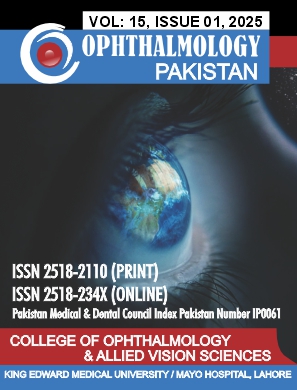To assess the Quality of life in Glaucomatous Patients who Underwent Trabeculectomy versus Medical treatment patients using the Glaucoma Quality of life-15 (GQOL-15) Questionnaire.
DOI:
https://doi.org/10.62276/OphthalmolPak.15.01.175Keywords:
glaucoma, GQoL, TrabeculectomyAbstract
Objective: To assess the Quality of life in Glaucomatous Patients who Underwent Trabeculectomy versus Medical treatment patients using the Glaucoma Quality of life-15 (GQOL-15) Questionnaire.
Study Design: cross sectional observational Study
Place and duration: The study was carried out at Hayatabad medical complex Peshawar from March (2019) to June (2019).
Methods and material: Ethical approval of the study was taken from the Ethical Committee of Hayatabad Medical Complex Hospital Peshawar. Patients with an established diagnosis of Primary Open-angle glaucoma with a minimum of one or more anti-glaucoma medications or a documented history of Trabeculectomy of the previous six months with no family history of glaucoma were selected for the study. The total number of patients in each group was 32. Complete eye examination was done in each patient. Then after examination, the fifteen quisenaries were asked from each patient and was documented. The data was then organized and analyzed using SPSS version 20.
Results : out of 64 patients, 32 patients were enrolled in each group. In both the groups male patients were more then femle patients and most of the participants in both groups were aged 20-40 years. The Medicine User group had a higher prevalence of diabetes and hypertension, and a greater percentage of right-eye involvement compared to the Trabeculectomy group.The IOP (Intraocular Pressure) range of 16-27 mmHg and C/D (Cup-to-Disc) Ratio range of 0.8-1.0. There was also significant differences (P < 0.001) in visual function scores by glaucoma severity (mild, moderate, severe). As severity increased, visual impairment worsened across all variables, with peripheral vision and total scores increasing from mild to severe cases.Similar trends were also found in the Trabeculectomy group, with worsening scores for peripheral vision, glare adaptation, and total scores as severity increased (P < 0.001). Severe cases had the highest scores across all variables. While compareing the visual function between groups, the Trabeculectomy group had significantly fewer impairments in all activities, including walking, judging foot distance, and adjusting to lighting, indicating better visual function compared to the Medicine User group (P < 0.001
Conclusion: Trabeculectomy may provide better functional vision outcomes in everyday activities compared to medication alone.






